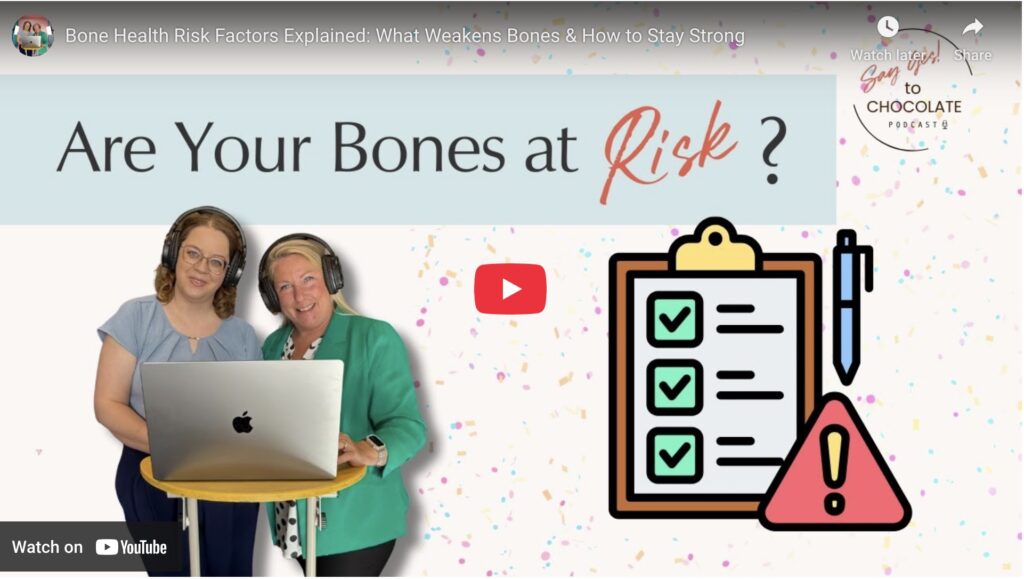Osteoporosis Risk Factors: What You Need to Know About Protecting Your Bones
Did you know women can lose up to 20% of their bone density during menopause? That’s a staggering stat—and it’s one of the reasons osteoporosis affects 1 in 2 women over 50.
But here’s the good news: while some risk factors for bone health are out of our control, there are plenty of shifts you can make to protect your bones and stay strong for decades to come.
Bone health matters because it’s not just about avoiding fractures—it’s about living with strength, independence, and vitality in midlife and beyond.
In this post, we’ll cover:
- The biggest risk factors for bone loss (both controllable and uncontrollable)
- Practical nutrition and lifestyle strategies for stronger bones
- Simple, sustainable shifts you can start today
- How to use the KISS Method™ to make it all doable
🎧 Listen to the full episode:
🎥 Watch the full episode:
Why Osteoporosis Risk Factors Matter
Our bones aren’t static—they’re living tissue that’s constantly being broken down and rebuilt. But as we age, the balance tips: bone breakdown can outpace new bone growth, especially for women in perimenopause and menopause.
Uncontrollable risk factors include:
- Gender → Women are at higher risk, especially after estrogen levels drop.
- Age → Peak bone mass is reached by age 30, and bone loss accelerates after menopause.
- Genetics → A family history of osteoporosis raises your personal risk.
- Medical conditions → Cancer treatments, thyroid disease, autoimmune disorders, celiac, and Crohn’s disease can all weaken bones.
Medications can also impact bone density, including:
- Proton pump inhibitors (acid reflux meds like Nexium, Prilosec or Omeprazole)
- Corticosteroids (for asthma, autoimmune conditions, or pain)
- Thyroid medications
- Certain antidepressants
The key takeaway: while you can’t change your age or genetics, you can control how you respond once you know your risk factors.
Practical Tips: Science Made Simple
So what actually strengthens your bones? It comes down to four nutrition powerhouses and a handful of lifestyle habits:
Nutrition Must-Haves
- Calcium → Found in dairy, dark leafy greens, broccoli, almonds, and fortified foods.
- Vitamin D3 → Helps your body absorb calcium.
- Vitamin K2 → Directs calcium to your bones (instead of your arteries).
- Protein → Bones are over 50% protein by volume—think of it as the 2x4s in your body’s framework.
Lifestyle Habits That Protect Bones
- Load-bearing exercise → Weight training, jumping, or osteogenic loading stimulates new bone growth.
- Balance & flexibility work → Walking, Pilates, yoga, or dancing reduce fall risk.
- Limit smoking & alcohol → Both accelerate bone loss and make bones more weak.
- Healthy body weight → Being underweight increases fracture risk.
How to Take Action (Small Shifts)
Protecting your bones doesn’t have to mean a massive lifestyle overhaul. Using the KISS Method™ (Keep It Simple & Sustainable):
🌟 K — Know Your Needs
Check your personal risk factors: age, family history, medications, and conditions.
🌿 I — Integrate Small Shifts
Add one extra serving of protein or leafy greens to your meals this week. Swap your current calcium supplement for one that includes vitamin D3 and K2.
🔍 S — Simplify Your Strategy
Focus on a few habits that matter most: nutrition, movement, and balance—not 20 new supplements.
💛 S — Support Your Body & Mind
Take a short walk after dinner, text a friend, or laugh with someone you love. Stress reduction supports bone health, too.
Encouragement & Big Picture
The truth is, you can’t control everything when it comes to your bones—but you can take powerful steps to strengthen them. Small shifts add up, and with consistency, your bones (and confidence) will thank you.
Remember: it’s not about being perfect—it’s about progress.
Closing
Your bones are your body’s foundation—and they deserve your care. Even one small shift this week can strengthen them for the long haul.
✨ Remember: better > perfect. And yes…always say yes to chocolate. 🍫

+ show Comments
- Hide Comments
add a comment